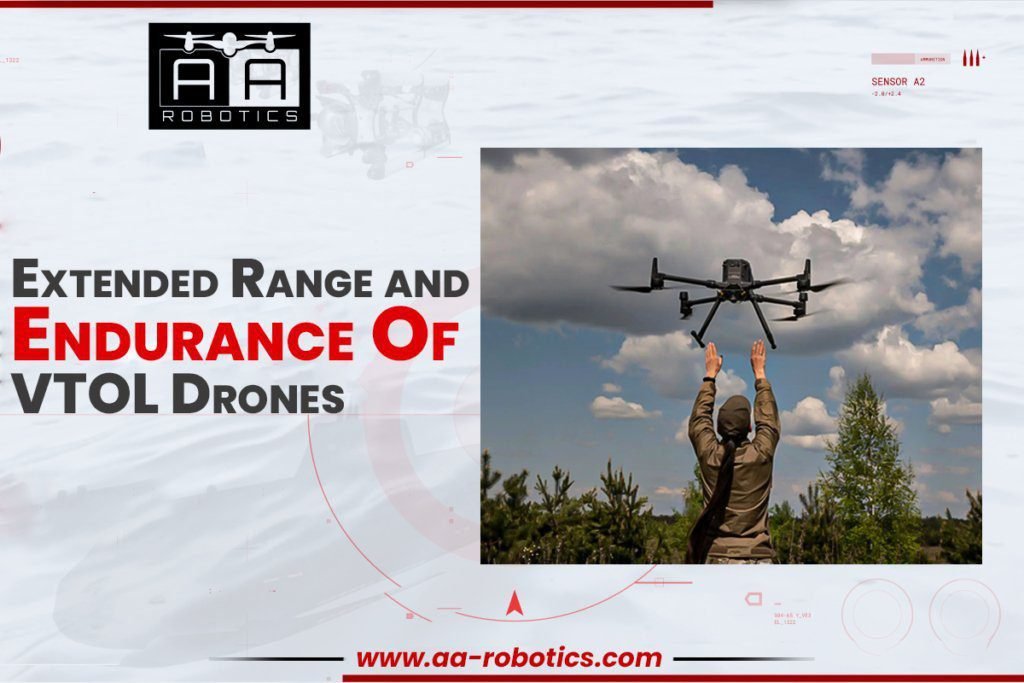
How VTOL Drones are Revolutionizing Aerial Operations
VTOL drones rank among the greatest of any technologies ever to occur in aerial operations. They are not like a helicopter, capable of taking off and landing vertically, but do this like a helicopter while retaining the range and efficiency of fixed-wing aircraft, just as multiple industries—from defence and agriculture to delivery and surveying—are being revolutionized by VTOLs. Their adaptability and versatility in many environments make them invaluable where the classical drones or aircraft are not serving the purpose. This AA Robotics article will surely delve deep into how VTOL drones revolutionize the aerial system by researching the key features, advantages, and applications that have catapulted VTOL adoption across the world.
Efficiency and Versatility Of VTOL Drones in Flight
One of the primary reasons VTOL drones are revolutionizing aerial operations is that they can take off and land vertically while at the same time offering efficient horizontal flight. Different from classical drones, which are based on either multi-rotor or fixed-wing designs, VTOL drones offer the capability to ascend and descend within a small area rather than requiring runway length, which significantly enhances their operational capabilities, both in urban and remote areas. Once airborne, they can switch to fixed-wing flight mode that allows cruising at a greater speed over long distances. Thus, they are extremely beneficial for areas of industrial use, such as agricultural inspection across vast areas, inspection of infrastructure, and monitoring of environmental conditions.
Like a helicopter, this ability to stay hovering in the air will allow VTOL drones to execute delicate operations such as delivering packages within dense urban surroundings, close-up bridge or tower inspections, or wind turbine ones. They can seamlessly switch back into fixed-wing flight when their work is complete to return immediately to base or to continue along their operations paths. This efficiency in flight makes VTOL more separated from traditional drones, which may need to have different models for different uses or have additional complex logistics to operate in varied environments.
Extended Range and Endurance Of VTOL Drones

Being fixed-wing in flight mode that cuts through drag and thus enhances aerodynamic efficiency, the drones tend to stretch larger areas more on a charge or load of fuel than their multi-rotor counterparts. This therefore greatly benefits them in applications such as mapping, surveying, and search-and-rescue missions where large areas need to be covered without frequent recharge or refuelling.
Not only do VTOL Drones offer the benefit of long-range capabilities but also extended alighting time, meaning that these are ideal for missions where continuous surveillance or monitoring is required. In military contexts, for example, VTOL drones can be used to patrol borders or track enemy movements for periods of several hours at a time in real-time, without human interference. This characteristic affords better consumption of resources, and it also diminishes the risks relating to manned operations in hazardous environments.
Overcoming Geographic Barriers with VTOL Drones
Another important advantage of VTOL drones is that they can cross geographical barriers that may make it impossible to use conventional aircraft or land-based vehicles. Such is the case in rugged and remote terrains where some roads may be impassable or do not exist at all. VTOL drones can move into such inaccessible areas. This makes them particularly useful in disaster response scenarios where access to affected areas should be quick and efficient in saving people and aiding in the recovery efforts.
In addition to that experience, VTOL drones have proven invaluable in maritime operations. From takeoff and landing on moving vessels to real-time monitoring of shipping lanes, fishing, and offshore installations, their agility and stability in turbulent conditions make them excellent tools in these tasks to enhance efficiency and safety in maritime operations and reduce reliance on manned helicopters or aircraft.
Advanced-Data Gathering and Interpretation
Integration of advanced sensors and cameras into VTOL drones serves as another driver of influence in aerial operations. High-resolution cameras, thermal imaging devices, LiDAR systems, and other leading-edge sensors can be integrated into VTOL drones to capture even the minutest data in real-time. This factor is revolutionizing construction, environmental conservation, and public safety by unveiling better and more timely insights into operational environments.
For example, VTOL drones could create 3D models of building sites, check the progress, and find potential problems before they become cost-prohibitive problems. Thus, VTOLs, providing real-time data, help project managers make better decisions and avoid delays or overrun budgets. Environmental conservation has had the added benefit of utilizing VTOL drones in tracking wild animals, monitoring deforestation, and estimating the effects of climate change on the ecosystem; this affords researchers extremely critical data that is very challenging or even impossible to obtain through natural processes.
Autonomous Operations and AI Integration
As AI and autonomous flight technologies have evolved, VTOL drones are even more powerful weapons in terms of aerial operations. Most modern VTOL drones can perform wholly autonomous missions, ending any need for human intervention within their operations. This feature is especially useful when the lives of the human pilots may be put at risk, such as in military operations, disaster response, or hazardous inspections.
Reduced Operational Costs and Risks
VTOL drones also revolutionize aerial operations by reducing operational risks and costs. Typical manned aerial operations require expensive equipment like helicopters or fixed-wing aircraft, along with specialized pilots and ground crews to operate and support these systems. The costs for fuel, maintenance, and logistics add up very quickly, so manned aerial operations are too expensive for most organizations.
In stark contrast, VTOL drones are much cheaper and launchable relatively quickly, with a relatively low requirement for extensive systems or manpower. Their large freedom of operation in a range of conditions without needing any runways or complicated infrastructure support systems cuts down operational costs even further, bringing their benefits to wider markets and applications. VTOL drones fly without risking the human pilot’s life while stationed in dangerous or inaccessible areas, which provides a safer human life in risky operations, such as firefighting, rescue search, or military surveillance, which requires the same level of coverage and data collection in real time.
Environmental Benefits and Sustainability
With the world going aggressive to have sustainability and reduce their carbon footprint, newer options for aerial operations are coming into shape in the direction of VTOL drones. Traditional manned aircraft like helicopters or small planes usually consume fossil fuels, whereas VTOL drones operate mostly on electrical power, which does not release any greenhouse gases while in flight. This change towards electric propulsion is also well contributing towards making the operations of aerials have a low impact on the environment and, therefore, more sustainable in the long term.
Also, VTOL drones require less power and space for their operations compared to traditional aircraft because they can take off and land in small spaces without any necessity to utilize long runways or airports. This will reduce the broad environmental impact of aerial works, especially for use in agricultural industries, in monitoring crops, fertilizers, and irrigation systems under minimal environmental impact. The ability of VTOL drones to collect data more efficiently and accurately benefits organizations in better decision-making on resource management, further promoting sustainability.
The Future of VTOL Drones in Aerial Operations:
Prospects of VTOL Drones’ Future in Aerial Operations The future of VTOL drones in aerial operation seems fairly bright with advancing technology. The future is most likely to witness enhanced capabilities with the battery, materials science, and AI provided the current pace of progress goes on steadily. Owing to incredible versatility in construction, logistics, delivery, agriculture, and environmental monitoring, one may see VTOL drones add up many vital roles in the years ahead.
Conclusion
In the defence segment, VTOL drones will certainly be a vital resource for surveillance and reconnaissance, as well as even for intents and purposes. The military can monitor and defend with real-time intelligence without risking human pilots in those activities. Even with autonomous flight technology improving, we will see the emergence of fully autonomous VTOL drones executing complex missions and getting the mission accomplished with little to no human involvement.
VTOL (Vertical Take-Off and Landing) drones are unmanned aerial vehicles that can take off, hover, and land vertically without using a runway.
They are meant for tasks such as surveillance, mapping, cargo delivery, and rescue missions. With this, they represent flexibility regarding urban and remote areas
They also marry the vertical take-off capabilities of helicopters with the range of fixed-wing aircraft, so they are very versatile for various applications.
Their capability to operate in confined spaces, longer flight times, and adaptability to different terrains are changing the way aerial operations are done.


